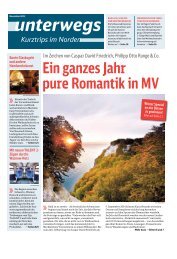Tagungsort Grand Hotel Heiligendamm
Tagungsort Grand Hotel Heiligendamm
Tagungsort Grand Hotel Heiligendamm
Sie wollen auch ein ePaper? Erhöhen Sie die Reichweite Ihrer Titel.
YUMPU macht aus Druck-PDFs automatisch weboptimierte ePaper, die Google liebt.
as well, more and more people start to swim;<br />
they learnt to swim. Before this, swimming<br />
was an unusual activity. Most people bathed<br />
in the sea, they didn’t swim in the sea. So this<br />
is a swimming lesson in Brighton in the late<br />
19th century. This photograph is of a staid,<br />
quiet, very respectable late-19th century beach<br />
scene. And then from the very late-19th century<br />
into the 20th century things change: the sun<br />
is discovered. Sunshine becomes the most important<br />
aspect of the seaside. And that totally<br />
changes how seaside architecture is used, what<br />
people do at the seaside, what they respond to,<br />
what they want to do. And by the 1930s in Britain<br />
and other European countries, a new architecture<br />
of the seaside emerged. This is the<br />
wonderful De La Warr Pavilion in Bexhill-on-<br />
Sea opened in 1935. The pavilion represented<br />
a new sort of architecture for the sunny seaside.<br />
At another extreme there were also little<br />
weekend beach houses, again building on that<br />
idea of the modernist seaside. Perhaps most<br />
iconic of all were the open-air lidos, again unheard<br />
of before the 1930s. This transformation<br />
of the seaside continued into the 1950s and<br />
1960s. It became a very different beach scene<br />
from the ones I showed you 70 or 80 years<br />
before. There were immense changes in terms<br />
of the culture of the seaside, its architecture<br />
and how nature was used.<br />
Turning to the third of my four sections, I<br />
now want to go on to talk about the challenges.<br />
As an expert audience you all probably know<br />
what the challenges are in terms of seaside architecture<br />
and seaside tourism, especially for<br />
northern resorts, for example, in Germany<br />
and Britain and on the north coast of France.<br />
First of all, there’s the challenge of nature or<br />
seemingly authentic nature provided in warm<br />
climates. There is the challenge of sunshine.<br />
I am always amazed by this photograph of<br />
the Italian Adriatic coast revealing masses of<br />
Italians who just want to lay in the sun and<br />
tan themselves. The challenge of the sun and<br />
warmth of the southern seaside still remains<br />
for us in the north. When large numbers of<br />
Italians start to come to the East Coast of<br />
Germany and the British seaside, we’ll know<br />
that this idea has stopped. The sun and the<br />
discovery of the sun have had, as you know,<br />
important implications for today.<br />
-<br />
<br />
can be pulled back. Technology can now reproduce<br />
the seaside in other forms. The palm<br />
ping<br />
the coastline. So the palm and motif idea,<br />
ped<br />
for contemporary purposes. As before,<br />
the same use of technology and use of capital<br />
to transform the seaside.<br />
We also have a series of challenges around<br />
redundant seaside structures: structures that<br />
were built for one long-gone or no longer<br />
fashionable purpose but which are too important<br />
or too expensive simply to demolish.<br />
How do we use those of derelict structures for<br />
modern seaside tourist purposes? Of course<br />
it’s not only Prora where this applies, but also,<br />
for example, around the coasts of Britain with<br />
disused holiday camps, and Italy with its often<br />
redundant children’s homes, colonies.<br />
Similar stories can be told of many seaside<br />
buildings. One structure that’s very close to my<br />
heart is the West Pier in Brighton. It opened<br />
in 1866 as an open promenade pier. As with<br />
much seaside architecture, the West Pier changed<br />
and developed over time. By the start of<br />
26
















